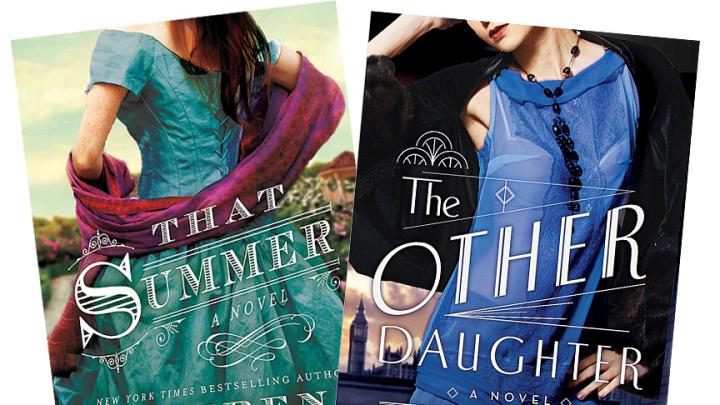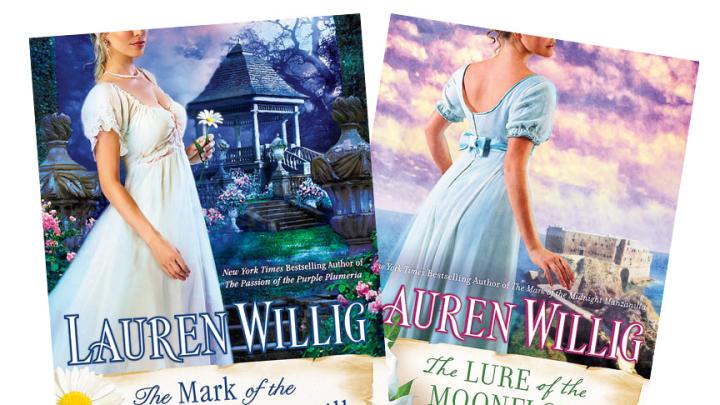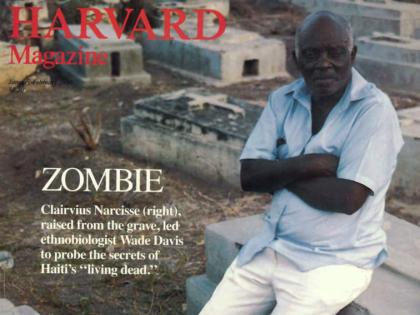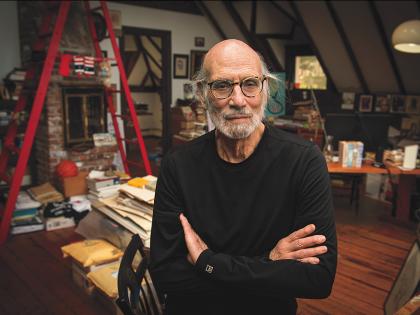“Of course their hook was ‘Harvard student writes bodice-ripper,’” says Lauren Willig, A.M. ’03, J.D. ’06. And of course it worked: the publisher’s strategy attracted “all sorts of media attention” to her novel The Secret History of the Pink Carnation.
Other lucky circumstances helped to make that 2005 debut a hit, like the cresting popularity of chick lit, Jane Austen spin-offs, and stories that switched between eras. Willig’s historical romance, its chapters shifting between past and present England to pursue two plots, had traces of all these trends. The historical half tells the story of a pair of lovers in the League of the Pink Carnation—a ring of aristocrat-spies, led by the mysterious Jane Wooliston, who serve their country during the Napoleonic Wars. Historian-heroine Eloise Kelly, an American abroad in search of fulfillment professionally (and of course, romantically), narrates the contemporary half.
Ten years and 14 books later, Willig is cheerfully matter-of-fact when describing her work and how it’s structured, marketed, and read. “Pink was very much a product of a certain moment in time,” she reflects. “Everything was light, and frivolous, and slightly silly....I personally could not write that book now, and even if I did, I don’t know if I could sell it now.” To her, romance novels are workaday objects, more artisanal than art. “The same way that you find that really beautiful furniture, that was designed for everyday use, winds up in the Victoria & Albert, the really good romance novels have outlasted their own period” and are seen as exemplars of their form. On the other end of the spectrum, she adds, there’s IKEA: mass-produced, functional, and ultimately disposable.
Many aspiring writers dream ardently about publication; Willig dreamt urgently. When she was nine, Simon & Schuster rejected her manuscript, and “I was just totally devastated, because I was going to be in double-digits next year! I was going to be old.” At the end of her second year of Harvard’s graduate program in history, she felt again that “This is now or never, make or break”—and so after sitting her general exams, she resolved to use the summer to write fiction. “I needed to do it before that sort of historical voice in my head was entirely dead. My characters were starting to think in footnotes.”
Readers might be struck by the similarities between the author and her narrator, Eloise—both are alumnae of an all-girls Manhattan private school (Chapin), with an academic interest in espionage and a taste for sleek shoes—but Willig chose a different specialty at Harvard (Tudor and Stuart, not Regency), and on her research year in England, did not stumble on a pristine and overabundant cache of old documents. Instead she discovered that she would rather practice law in New York City than be a professor anywhere else, and decided to follow what she calls a family tradition of “lawyers who are lapsed academics.”
As Willig started her first year of Harvard Law School, a publisher bought Pink Carnation and its eventual follow-up, The Masque of the Black Tulip, which “thrilled and bewildered” her. Had she gotten the contract earlier, she’s not sure that she would have applied or enrolled—“But of course, once there, I was going to see it through.” She wrote between semesters (except when, as a summer associate at a big New York firm, she was assigned to the Enron case) and, after graduation, on weekends when she wasn’t called into the office. On her one-week vacations, she retreated to Starbucks, typing furiously to meet her publisher’s deadlines; while away on publicity tour, she did her day job remotely. During the five years of that double life in letters and law, Willig produced four books. Eventually, she left the firm to write full-time, and at peak speed produced three full-length manuscripts in a year, as well as a handful of shorter works.
This July brings The Lure of the Moonflower, which concludes the Pink Carnation series. Willig’s other new work, The Other Daughter, will come out the same month—but it will be shelved at a distance. Published in handsome hardcover, it’s a stand-alone story in which the prose is less winking, the banter has a steelier edge, and the romance runs on revenge rather than high-spirited high jinks. By now, Willig’s a seasoned naturalist in the wilds of commercial publishing. Having mastered its taxonomy of subgenres, she can name the diverse species of romance and historical fiction; she can tell which are thriving and which are dying out. Yet she embarks on the next phase of her career with that old sense of urgency: “I needed to do something different,” she says, but she also wanted to end the series on her terms. Her literary agent had advised that her future would be in heavier historical fiction—an industrial reality reflected in how Pink Carnation and its sequels had shifted from hardcover to mass-market paperback; the next step was digital-only, or cancellation. “This kind of light humor—there isn’t much of a place for it anymore. The genre has gone more serious,” she explains. “I was very afraid that if I dawdled, I wasn’t going to be able to wrap it up.”
There were other, internal, factors: “I had to make a real effort to remember what it was to be Eloise, or in her position.” At first, author and character were essentially contemporaries—in fact, Eloise was a few months ahead in her semester. But the gap between them has inverted and widened as Willig entered and left the law, got married, and had a daughter; Eloise, lagging behind, only just abandoned Harvard.
Revisiting the reviews of her early work, Willig finds herself agreeing with those who described it as “relentlessly effervescent” and the characters as “young and carefree.” She believes the series has grown up along with her. After nearly a dozen novels’ worth of staying in the shadows, donning disguises, directing her operatives, and gathering intelligence, the hyper-competent Jane (alias the Pink Carnation) at last gets to tend to her private affairs. As for Eloise? Happily-ever-after comes with wedding bells—and a book deal.











